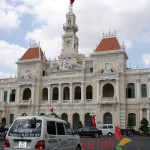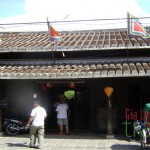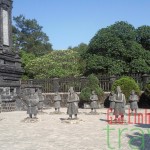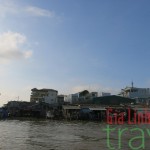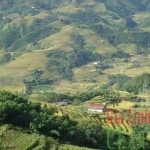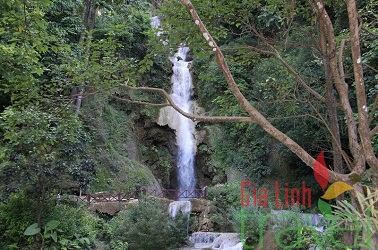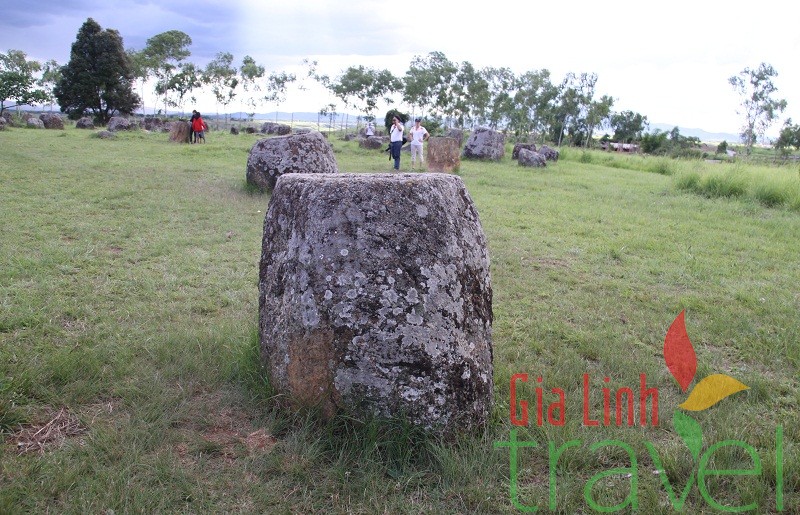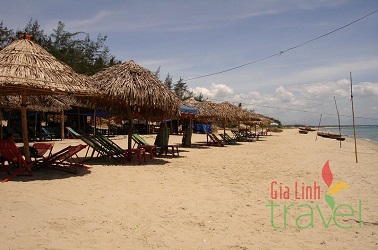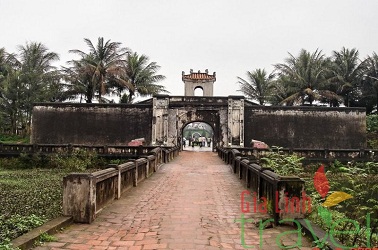Destination: Ho Chi Minh City/Tay Ninh/Cu Chi/Mekong Delta/Hue/Danang/Hoi An/My Son/Hanoi/Ha Long/Sapa/Luang Prabang/Pakou/Khouangsi Waterfalls/Xieng Khouang/Vientiane/Don Khone Island/Tadlo/Pakse
B=Breakfast, L=Lunch, D=Dinner, G=Guide
Day 1: Ho Chi Minh City arrival (D, G)
Arriving at the airport, you’ll be met and driven to your hotel. You’ll have time to relax after your journey before a welcome dinner. Your overnight stay will be in Ho Chi Minh City.
Day 2: Ho Chi Minh city tour (B, L, G)
After breakfast, you’ll start your city tour including the History Museum (special exhibition of the 5thC “Oc Eo” civilisation), the Museum of War Remnants (very partial, but riveting, recollections of the “American War”: not for the squeamish), the huge Ben Thanh market (one of the liveliest areas of Ho Chi Minh City), the Jade Emperor Temple (superb effigies, remarkable carved panels of the descent to Hell and incongruous terrapin and tortoise sanctuaries) and a lacquer workshop. Overnight in Ho Chi Minh City.
Day 3: Ho Chi Minh/Tay Ninh/Cu Chi (B, L, G)
Drive to Tay Ninh to visit the Cao Dai Holy See (in time to watch the mid-day ceremony), Cu Chi (intricate network of underground passages and bunkers that became legendary during the 1960′s for their role in the war of liberation). Overnight in Ho Chi Minh City.
Cao Dai is a “new” religion unique to Viet Nam with around a million followers. Both its creed and its architecture are remarkable and exotic.
Day 4: Ho Chi Minh City/Vinh Long (B, L, D, G)
Drive to Vinh Long, cruise on Mekong River to visit traditional family-run brick kilns and a wide range of varied cottage industries, e.g. Overnight stay in an orchard house of local people beside canals.
Day 5: Vinh Long/Ho Chi Minh City (B, L, G)
Morning boat cruise to visit a bonsai garden, the old house, local houses making confectionery and Cai Be floating market. You’ll also have chance to enjoy the Mekong Delta music performed by local people. Afternoon return to Ho Chi Minh City for an overnight stay.
Day 6: Ho Chi Minh/Hue (B, G)
Noon flight to Hue, check-in, then to the Thien Mu Pagoda (beside the Perfume River – very tranquil), boat cruise to King Minh Mang’s Tomb (the most majestic of the Royal Tombs) and drive to visit the Dong Ba market. Overnight in Hue.
Day 7: Hue 1 day (B, L, G)
Morning visit to the Imperial Citadel of Hue and the Antiquity Museum. Afternoon drive to visit King Tu Duc’s Tomb (the poet King, the simplest Royal tomb set in a beautiful garden) and visit to Garden Houses – (a cultural characteristic in Hue). In the evening you’ll be picked up to enjoy a Hue musical show on a boat in the Perfume River for about one hour. Overnight in Hue.
Day 8: Hue/Danang/Hoi An (B, L, G)
Morning drive to Danang (excellent views from high mountain pass). On arrival in Danang, you’ll have a brief visit to Cham Museum, then continue to travel to Hoi An. After lunch, a guided visit to the Ancient Town. Overnight stay in Hoi An.
The town is an ancient trading port, once the largest in Indochina and a meeting point for many cultures that left their mark in the different architectural features of its wooden buildings.
Day 9: Hoi An/My Son (B, G)
Morning drive to My Son Sanctuary – World Heritage Area. Free afternoon and overnight in Hoi An.
Once the My Son Sanctuary was the spiritual capital of the Cham Kingdom that dominated SE Asia for nearly a thousand years. Its remarkable brick towers were badly bombed by the Americans, but are still impressive as is its remote valley setting.
Day 10: Hoi An/Danang/Hanoi (B, G)
After breakfast, the car will take you to the airport for your flight to Hanoi. On arrival, you’ll be met and driven to your hotel. Your overnight stay will be in Hanoi.
Day 11: Hanoi City tour (B, L, G)
An all day city tour, possibly including the Temple of Literature, (the first university in Vietnam dating back to the 11th C), the Ho Chi Minh Mausoleum, the Ethnology Museum and the centre of Hanoi, including the Hoan Kiem Lake, the Ngoc Son temple and the bustling Old Quarter with a complex of architecture – traditional tube houses, religious buildings and the colonial houses. In the evening, you’ll have tickets for a performance of Cheo (an traditional music typical for the northern Vietnam). Overnight in Hanoi.
Day 12: Hanoi/Ha Long (B, L, D, G)
A morning drive to Ha Long Bay, (one of the most spectacular UNESCO World Heritage Areas – the world’s largest marine “karst” landscape). Travel by traditional-style boat to some of the less well-known grottoes and caves. Includes swimming, fishing, hill (not mountain) climbing for Bay overviews, exploring sea level caves in a small sampan, etc. All meals will be provided on board and your accommodation will be on the boat in a twin room with en suite toilet and shower.
Day 13: Ha Long/Hanoi/Lao Cai (B, L, G)
Morning cruising Ha Long Bay, followed by lunch and then return to Hanoi for refreshment at a local hotel before board a overnight train to Lao Cai. Overnight on the train.
Day 14: Lao Cai/Sapa (B, L, G)
Overnight train from the previous night and arrive in the early morning. You’ll be picked at the station to travel to a remote ethnic market. Afternoon return to Sa Pa town for overnight stay.
The trips to ethnic markets are a fascinating experience but must be on Tuesday (Coc Ly Market), Saturday (Can Cau Market) or Sunday (Muong Hum and Bac Ha Markets).
Day 15: Sapa/Lao Cai (B, L, G)
Morning stroll to the town busy market and then easy trek to ethnic villages of H’mong in a scenic valley. After stream-side picnic lunch, you’ll be picked up to visit other ethnic villages of the H’mong, Day and Red Dao people. Return to Sa Pa and then back to Lao Cai station for an overnight train to Hanoi.
Day 16: Hanoi/Luang Prabang (B, G)
Arrive in Hanoi, the car will take you to the local hotel for refreshment. You’ll be free until transfer to airport for your flight to Luang Prabang. Upon arrival at the airport, you will be met and transferred to your hotel. Luang Prabang is perhaps the best-preserved traditional city in Southeast Asia. The tranquility and charm of this town with its splendid natural scenery and cultural sights make it one of the most delightful places to visit in Laos. After a short rest, we visit the impressive stupa of Wat Visoun and the shrines of Wat Aham and Wat Mai. We then climb up to the top of Mount Phousi for an enjoyable exploration of the sacred, gilded stupa as well as a beautiful sunset view of the city and the Mekong River. From there, we explore the Night Market, where you can find a lovely selection of handmade textiles made by the local and hilltribe people surrounding Luang Prabang. Overnight in Luang Prabang
Day 17: Luang Prabang/Pakou/Luang Prabang (B, L, G)
After breakfast, we enjoy a short-guided tour seeing the city’s oldest temple Wat Sene and the magnificent Wat Xiengthong with its roofs sweeping low to the ground, representing classical Laotian architecture. We then board a cruise upstream on the Mekong River, which gives us a panoramic view of the tranquil countryside as well as an interesting visit to the mysterious Pak Ou Caves, two linked caves crammed with thousands of gold lacquered Buddha statues of various shapes and sizes left by pilgrims. En route, we stop at the village of Ban Xanghai, where the local speciality of rice wine is produced. Once back in Luang Prabang city we take a short drive to Ban Phanom, a village well known for its hand weaving. We also have time to visit Ban Xangkhong and Ban Xienglek, small villages well known for silk weavings and for Saa (jute) Papermaking Overnight in Luang Prabang.
Day 18: Luang Prabang/Pakou/Khouangsi Waterfalls (B, L, G)
An optional early start gives you the fantastic opportunity to participate in the daily morning rituals of saffron-clad monks collecting offerings of Alms (often in the form of sticky rice) from the faithful residents. This tradition is very unique in Laos, being the only Buddhist nation still preserving the ritual. You can also visit the morning Phosi Market where you canl see such diverse offerings as dried buffalo skin, local tea and saltpeter among the chickens, vegetables and hill-tribe weavings. Laos is also known for its traditional handicrafts, and today you will visit local village of Lao ethnic minority groups at Ban Ouay and Ban Thapene. Time permitting you may also wish to drive to the beautiful Khouangsi Waterfall where you can take a dip in the inviting pools or walk along the forest paths. We return to Luang Prabang by late afternoon and continue to Ban Phanom, a well-known weaving village, and then return to the city by late evening to admire the sunset at Wat Siphouthabath. Overnight in Luang Prabang
Day 19: Luang Prabang/Xiengkhouang (B, L, G)
After breakfast, we visit the National Museum (close Tuesday) at the former Royal Palace, which displays a lovely collection of artefacts reflecting the richness of Lao culture dating from the days of the early kings right through the last sovereign. Today, we drive 306km uphill a mountain surrounded by wonderful natural scenery to Xiengkhouang. Upon arrival, we transfer out to visit the Plain of Jars, an impressive archaeological site where hundreds of large stone jars are scattered all over the plateau. If time permits, we see the old capital of Muang Khoun and the nearby villages, home to the Hmong hill tribe people. They have an interesting local culture and a colorful history. Overnight in Phonsavanh
Day 20: Xiengkhouang/Vientiane (B, L, G)
Following breakfast, we visit the Central Market. After you will have free time to explore the town further before catching our flight back to Vientiane. After checking into the hotel, time permitting we continue our sightseeing tour of the surrounding areas of Vientiane; we visit the impressive Lao-Thai Friendship Bridge and Buddha Park, an enchanting collection of Buddhist and Hindu sculptures on the Mekong Riverside meadow, close to the Friendship Bridge. There are approximately 200 religious images dating back over 500 years, which were created by a mysterious monk spreading his philosophy on life and revealing his ideas about the universe. A spectacular view of the Mekong River at sunset is a perfect way to finish the day. Overnight in Vientiane
Day 21: Vientiane (B, L, G)
AM: After breakfast, we continue to explore Vientiane capital by visiting the major sights of the capital; including the oldest Wat Sisaket with thousands of miniature Buddha statues and the former royal temple of Wat Prakeo, which previously housed the famous Emerald Buddha Image. . Enroute to Lao’s national precious heritage, the famous and sacred structure of That Luang Stupa, you will have the opportunity to take some pictures of the imposing Patuxay Monument, which is well known as Vientiane’s own Arc de Triumph.
PM: We continue visiting the rest of Vientiane by foot, including Wat Ong Tue, Wat Inpeng and Wat Haisok. We pass by the major shopping area continuing to the Vientiane Central Market of Talad Sao and Talad Kouadin where various goods are displayed for sale; including fresh food, household goods, souvenirs, textiles, gold, silver and antiques. We return to the Mekong Riverside in the late afternoon for observing the sunset. Overnight in Vientiane
Day 22: Vientiane/Pakse/Don Khone Island (B, L, G)
After breakfast, we catch an early flight to Pakse. On arrival, we drive south to Champassak and tvisit the fascinating pre-angkorian ruins of Wat Phu, one of Southeast Asia’s most dramatically situated temples. We have time to explore these intriguing Khmer ruins, which are perched at the base of Mount Phu Kao. We continue our journey by long tail boat to Don Khone, the largest island in the South Mekong river region known as the 4000 islands, one of the most scenic areas in Laos. Overnight on Don Khone Island
Day 23: Don Khone Island Surrounding (B, L, G)
After an early morning breakfast, we begin by re-tracing the French colonial-past at Ban Khone, where some old colonial houses still stand and glimpse the first Lao railway with its own locomotive. We continue our exploration of the area of the 4000 islands leisurely by boat and visit the most beautiful Liphi waterfall, also known as the Samphamith, which forms a natural border between Lao and Cambodia. If we have luck, we may catch a glimpse of the rare freshwater Irrawaddy Mekong dolphin at Ban Hang Khone. We return to Ban Nakasang and drive to the famous waterfall of Khone Phapeng – the largest waterfall in South East Asia, also known as the ‘Niagara of the east’. Overnight on Don Khone Island
Day 24: Don Khone Island/Tadlo/Pakse (B, L, G)
Upon leaving Done Khone Island, we journey towards Tadlo, through the Boloven plateau. The Boloven Plateau is known for its cooler temperature being located high above the Mekong Valley. Rivers run off this high plateau in all directions and then plunge out to lush forests along in a series of spectacular surging waterfalls. A trip to the plateau provides a refreshing break from the heat and allows you to observe the cultivation of rich coffee, tea, cardamom, bananas, and other crops that can be seen en route. This trip gives visitors the chance to venture off the beaten track and to discover some of the lesser-known areas of Laos, exploring the wild beauty of this southern region. Upon arrival at Tad Lo waterfall, we visit the villages of Alak, Nge, and Katu, populated by ethnic minority groups. We return to Pakse by late evening. Overnight in Pakse
Day 25: Pakse departure (B, G)
After breakfast; there will be free time for your own exploration of Pakse Town before catching a flight to Siem Reap-Cambodia or exiting Laos overland from the Chongmek International checkpoint to Ubon Ratchathani Thailand.
